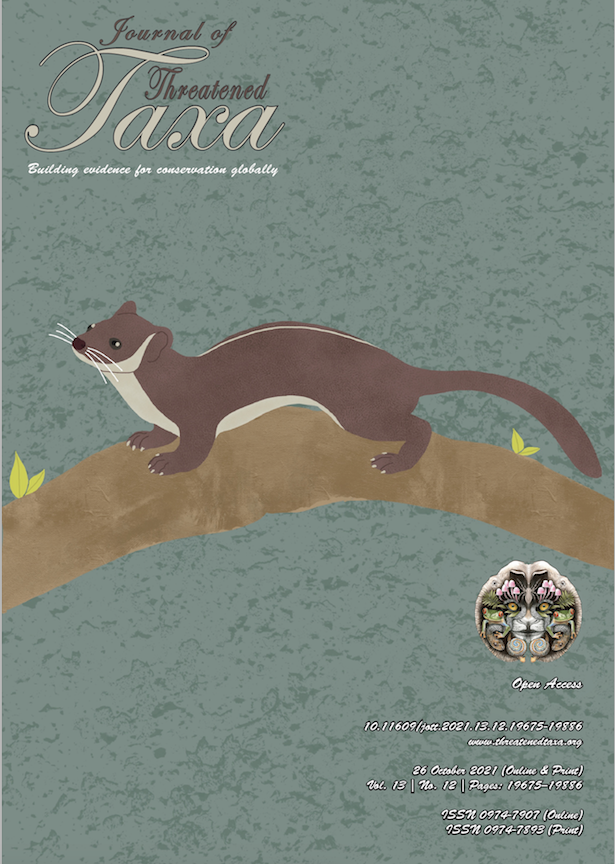On the pteridophytes of Bherjan-Borajan-Padumoni Wildlife Sanctuary, Assam, India
Main Article Content
Abstract
A preliminary survey on the pteridophytic flora of Bherjan-Borajan-Padumoni Wildlife Sanctuary of Assam, India revealed a total of 33 species belonging to 23 genera and 15 families. Most of the species belong to the family Pteridaceae followed by Polypodiaceae and Thelypteridaceae. A brief taxonomic description of each species is provided. Stenochlaena palustris (Burm.f.) Bedd., an edible fern, grows abundantly all over, especially in the openings and clearings.
Article Details

This work is licensed under a Creative Commons Attribution 4.0 International License.
Authors own the copyright to the articles published in JoTT. This is indicated explicitly in each publication. The authors grant permission to the publisher Wildlife Information Liaison Development (WILD) Society to publish the article in the Journal of Threatened Taxa. The authors recognize WILD as the original publisher, and to sell hard copies of the Journal and article to any buyer. JoTT is registered under the Creative Commons Attribution 4.0 International License (CC BY), which allows authors to retain copyright ownership. Under this license the authors allow anyone to download, cite, use the data, modify, reprint, copy and distribute provided the authors and source of publication are credited through appropriate citations (e.g., Son et al. (2016). Bats (Mammalia: Chiroptera) of the southeastern Truong Son Mountains, Quang Ngai Province, Vietnam. Journal of Threatened Taxa 8(7): 8953–8969. https://doi.org/10.11609/jott.2785.8.7.8953-8969). Users of the data do not require specific permission from the authors or the publisher.
References
Baishya, A.K. & R.R. Rao (1982). Ferns and Fern-allies of Meghalaya State, India. Scientific Publisher, Jodhpur, 162 pp.
Borthakur, S.K., P. Deka & K. Nath (2001). Illustrated Mannual of Ferns of Assam. Bishen Singh Mahendra Pal Singh, Dehra Dun, 468 pp.
Borthakur, S.K., D. Baro, A. Bawri & A. Baro (2018). Flora of BTAD (Bodoland Territorial Area Districts, Assam), Pteridophytes and Gymnosperms. Eastern Book House Publisher, India, Vol.1, 152 pp.
Chandra, S. (2000). The Ferns of India (Enumeration, Synonyms & Distribution). International Book Distributors, Dehradun, India.
Chapman, A.D. (2009). Numbers of Living Species in Australia and the World Report for the Australian Biological Resources Study Canberra, Australia, September 2009. http://wwwenvi ronmentgovau/biodiversity/abrs/publications/other/species/numbers/indexhtml.
Devi, J. & H.C. Majumdar (2003). A study on Pteridophytic flora Byrnihat and Umtru area of Meghalaya State. Plant Archives 3(2): 207–213.
Dixit, R.D. (1984). A Census of the Indian Pteridophytes. Botanical Survey of India, Howrah.
Dutta, A.K., T.K. Dutta & K.K. Gupta (1980). A tentative accounting of the forest flora of North Cachar Hills and Barail range-II: Enumeration of spores of Pteridophytes. Indian Forester 106: 34–40.
Fraser-Jenkins, C.R. (2009). A brief comparison of modern pteridophyte classifications (families and genera in India). Indian Fern Journal 26: 107–126.
Fraser-Jenkins, C.R., K.N. Gandhi, B.S. Kholia & A. Benniamin (2017). An annonated checklist of Indian pteridophytes part-1. Bishen Singh Mahendra Pal Singh, Dehradun, India, 562 pp.
Handique, P.J. & G. Konger (1986). A list of Ferns and Fern allies of greater Guwahati (Assam) with their ecological adaptation. Mendel 3(2): 130–135.
Jain, S.K. & R.R. Rao (1977). A Handbook of Field and Herbarium Methods. Today & Tomorrow’s Printers and Publishers, New Delhi, 157 pp.
Jamir, N.S. & R.R. Rao (1988). The Ferns of Nagaland. Bishen Singh Mahendra Pal Singh, Dehra Dun, India, 426 pp.
Kachroo, P. (1953). Ferns of Assam. Journal of Asiatic Society, Bengal. 29: 161–174.
Kachroo, P., S.S. Bir & S.M. Vasudeva (1989). Pteridophytic flora of North-Eastern India-II (families: Cryptogramaceae-Thelypteridaceae. Indian Fern Journal 6: 78–99.
Kalita, P.C. (2015). Survey for pteridophytic diversity in Madan Kamdev Hill region of Assam, India. Pleione 9(2): 376–400.
Moran, R.C. (2015). An overview of ferns and lycophytes Opening Symposium Abstract (p5) In ‘Next Generation Pteridology’ [An International Conference on Lycophyte and Fern Research], Smithsonian Institution and US Botanic Garden, Washington DC; June 1–5, 2015 Book of Program and Abstracts, Pp 74
Panigrahi, G. (1960). Pteridophytes of eastern India-1 Enumeration of the species collected and their nomenclature. Bulletin of Botanical Survey of India 2: 309–314.
Panigrahi, G. (1968). Studies in the Polypodiaceae in eastern India: distribution and ecology. Journal of Indian Botanical Society 47: 1–6.
Panigrahi, G. & S. Choudhury (1961). Taxonomic studies on the Aspidiaceae of Eastern India. Proceeding of Indian Science Congress 48: 272.
Panigrahi, G. & S. Choudhury (1962). Enumeration and distribution of fern allies in Eastern India. Proceeding of Indian Science Congress 49: 255–256.
Sen, A. & P.D. Ghosh (2011). A note of the ethnobotanical studies of some pteridophytes in Assam. Indian Journal of Traditional Knowledge 10(2): 292–295.

